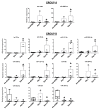Circulating miRNAs as Promising Biomarkers to Evaluate ECMO Treatment Responses in ARDS Patients
- PMID: 34436314
- PMCID: PMC8398026
- DOI: 10.3390/membranes11080551
Circulating miRNAs as Promising Biomarkers to Evaluate ECMO Treatment Responses in ARDS Patients
Abstract
The use of extracorporeal membrane oxygenation (ECMO) for acute respiratory distress syndrome (ARDS) has increased in the last decade. However, mortality remains high, and the complexity of ECMO requires individualized treatment. There are some biomarkers to monitor progression and predict clinical outcomes of ARDS. This project aims to advance the management of ARDS patients treated with ECMO by exploring miRNA expression in whole blood. The analysis was conducted on two groups with different length of ECMO: Group A (longer runs) and group B (shorter runs). We analyzed miRNAs before ECMO cannulation, and at 7 and 14 days of ECMO support. Our results showed that in the group B patients, 11 deregulated miRNAs were identified, and showed an opposite trend of expression compared to the group A patients. In silico analysis revealed that these 11 miRNAs were related to processes involved in the pathogenesis and evolution of ARDS. This scenario could represent homeostatic mechanisms by which, in ECMO responsive patients, pathways activated during ARDS progression are switched-off. Circulating miRNAs could represent promising biomarkers to monitor the evolution of ARDS under ECMO support. Further studies may shed light on this topic to improve a personalized approach in such a complex setting of patients.
Keywords: ARDS; ECMO; biomarkers; miRNAs.
Conflict of interest statement
The authors declare no conflict of interest.
Figures







References
-
- Zangrillo A., Landoni G., Biondi-Zoccai G., Greco M., Greco T., Frati G., Patroniti N., Antonelli M., Pesenti A., Pappalardo F. A meta-analysis of complications and mortality of extracorporeal membrane oxygenation. Crit. Care Resusc. J. Australas. Acad. Crit. Care Med. 2013;15:172–178. - PubMed
-
- Holzgraefe B., Broome M., Kalzen H., Konrad D., Palmer K., Frenckner B. Extracorporeal membrane oxygenation for pandemic H1N1 2009 respiratory failure. Minerva Anestesiol. 2010;76:1043–1051. - PubMed
LinkOut - more resources
Full Text Sources

